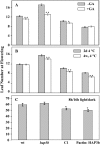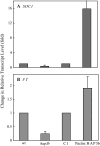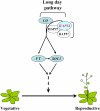A putative CCAAT-binding transcription factor is a regulator of flowering timing in Arabidopsis
- PMID: 17631525
- PMCID: PMC1976580
- DOI: 10.1104/pp.107.102079
A putative CCAAT-binding transcription factor is a regulator of flowering timing in Arabidopsis
Abstract
Flowering at the appropriate time of year is essential for successful reproduction in plants. We found that HAP3b in Arabidopsis (Arabidopsis thaliana), a putative CCAAT-binding transcription factor gene, is involved in controlling flowering time. Overexpression of HAP3b promotes early flowering while hap3b, a null mutant of HAP3b, is delayed in flowering under a long-day photoperiod. Under short-day conditions, however, hap3b did not show a delayed flowering compared to wild type based on the leaf number, suggesting that HAP3b may normally be involved in the photoperiod-regulated flowering pathway. Mutant hap3b plants showed earlier flowering upon gibberellic acid or vernalization treatment, which means that HAP3b is not involved in flowering promoted by gibberellin or vernalization. Further transcript profiling and gene expression analysis suggests that HAP3b can promote flowering by enhancing expression of key flowering time genes such as FLOWERING LOCUS T and SUPPRESSOR OF OVEREXPRESSION OF CONSTANS1. Our results provide strong evidence supporting a role of HAP3b in regulating flowering in plants grown under long-day conditions.
Figures





References
-
- Alonso JM, Stepanova AN, Leisse TJ, Kim CJ, Chen HM, Shinn P, Stevenson DK, Zimmerman J, Barajas P, Cheuk R, et al (2003) Genome-wide insertional mutagenesis of Arabidopsis thaliana. Science 301 653–657 - PubMed
-
- Amasino RM (2005) Vernalization and flowering time. Curr Opin Biotechnol 16 154–158 - PubMed
-
- An HL, Roussot C, Suarez-Lopez P, Corbesler L, Vincent C, Pineiro M, Hepworth S, Mouradov A, Justin S, Turnbull C, et al (2004) CONSTANS acts in the phloem to regulate a systemic signal that induces photoperiodic flowering of Arabidopsis. Development 131 3615–3626 - PubMed
-
- Ben-Naim O, Eshed R, Parnis A, Teper-Bamnolker P, Shalit A, Coupland G, Samach A, Lifschitz E (2006) The CCAAT binding factor can mediate interactions between CONSTANS-like proteins and DNA. Plant J 46 462–476 - PubMed
-
- Cardon GH, Hohmann S, Nettesheim K, Saedler H, Huijser P (1997) Functional analysis of the Arabidopsis thaliana SBP-box gene SPL3: a novel gene involved in the floral transition. Plant J 12 367–377 - PubMed
Publication types
MeSH terms
Substances
LinkOut - more resources
Full Text Sources
Other Literature Sources
Molecular Biology Databases
Research Materials

